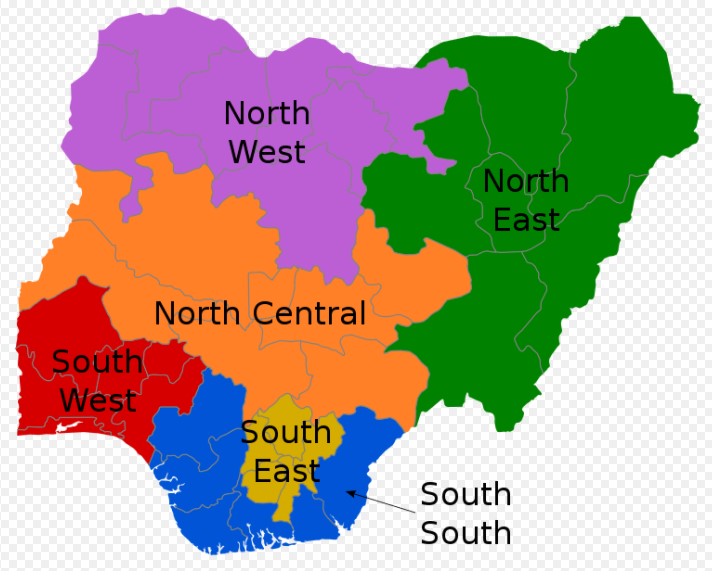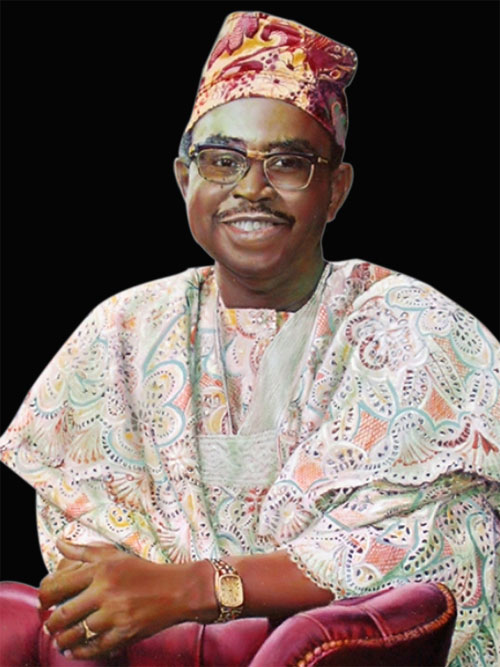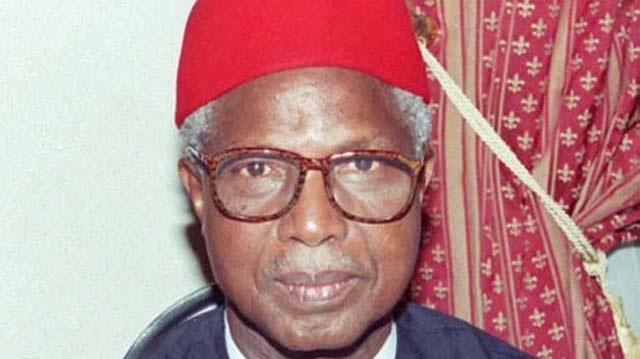The idea of the 6 geopolitical zones was developed by former Vice President Dr Alex Ekwueme and former Ogun State Governor, Chief Bisi Onabanjo, when they were in prison between 1983 and 1985.
Dr Ekwueme was the brain behind the idea, while Chief Onabanjo made contributions.
The basic idea was to provide equality between the regions of Nigeria. During the 1st Republic, Northern Nigeria was bigger than the other 2 regions (East and West) combined and there were always fears that it would dominate the country. Dr Ekwueme decided to address this issue by creating a balance.
Furthermore, minority ethnic groups were always complaining that they were being dominated by the 3 big ethnic groups and so his idea was developed in such a way that the minorities would have a voice.
In his idea, there would be an Eastern Region which would be mainly made up of the Igbo ethnic group and a Western Region that would be mainly made up of the Yoruba ethnic group. There would then be a South-South Region that would be mainly made up of the southern minorities.

There would also be a North-Western Region which would be mainly made up of the Hausa and Fulani ethnic groups and a North-East Region which would be mainly made up of the Kanuri ethnic group. There would then be a North-Central Region that would be mainly made up of the minorities in the North.
Dr Ekwueme presented his ideas to former President Shehu Shagari when he left prison. President Shagari had previously suggested something similar, but he told Dr Ekwueme that he had abandoned the idea because people did not accept it.
Dr Ekwueme then presented the idea at the 1995 Constitutional Conference. The idea was rejected, but the head of state, General Abacha, liked and accepted it.

In this interview Dr Ekwueme explains how and why he came up with the idea. The interview was conducted and published a few years before his death and it was republished after his death.
How Ekwueme, Bisi Onabanjo plotted six geopolitical zones from prison
ON NOVEMBER 25, 2017
The idea of the six geopolitical zones looks brilliant. Was it your idea alone?
The only other person who contributed to it was my friend, Bisi Onabanjo. Two of us discussed this in prison.
It was from there you now took it to the Constitutional Conference where it was adopted?
Well, it wasn’t. But Abacha adopted it. The conference itself didn’t adopt it; they wanted the status quo to remain because it was in the interest of some people to maintain the status quo.
Some have suggested the abolition of the states and for the six geopolitical zones to become the federating bodies. Do you concur?
The states don’t have to be abolished. It is a matter of nomenclature. When we had Eastern Region, we had 12 provinces which Michael Okpara created. Ogoja province, Calabar Province, Uyo Province, Annang Province, Enugu Province, Onitsha Province, Owerri Province, Umuahia Province and Port-Harcourt Province, Degema Province. There were six provinces in the minority areas and six in the Igbo areas, and all these provinces had their provincial commissioners, had their assemblies and had their provincial scholarship boards.
So, it is a matter of nomenclature. The states should be provinces of the regions. I am putting together a book called Nigeria: Thoughts on the provision of a stable polity, and in that book, there is an article by Shehu Shagari that states should become provinces of the regions.
Eventually, when I met with him when I was putting together these ideas, he said that he found that his suggestion was not very well accepted, so he wasn’t pursuing it anymore.
What kind of political structure do you think will make Nigeria politically and economically viable?
Going back to history we negotiated over a decade starting from Ibadan Conference in 1951 up to the conferences in Nigeria in London and so on until independence in 1960 – a ten year period of negotiation and in the end what Nigerians agreed with the colonial masters on what would be the form of government on the basis of which they would be given independence was a federal form of government made up of three regions – North, East and West.
That was the form of government agreed with each region autonomous in many respects and with each region having its own Constitution and the Constitutions of the three regions annexed to the Federal Constitution in one document and with each region being able to develop at its own pace.
You will see for instance, Eastern Region that started as the poorest region, by 1966 the leadership had established agricultural plantations, rubber, cocoa plantations in Cross River State, palm in Anambra, Imo, Rivers and so on and they had industries, like Trans Amadi Industrial Estate in Port Harcourt, they were able to negotiate with foreign countries and were able to build the brewery in Umuahia, ceramic factory in Umuahia, the Calabar Cement Factory and there was development. They were able to build the University of Nigeria before the Federal Government took it over ten years after.
So, each region was given the freedom to exercise its initiative. It was Eastern Region that first started the Pay As You Earn tax in Nigeria. That was the creation of -21- Bon Ejike— the first minister of finance of Eastern Region in 1952 – Pay As You Earn, automatic deduction from salary. It was first started in Eastern Nigeria because when the region was founded they had to find means of raising money. It was in the East that they first started Entertainment Tax, if you went to cinema if it was One and Six, you paid three pence tax to the government.
People used their initiative. If you went to the North you would find groundnut pyramids in Kano everywhere. In the West, cocoa was booming and they used it to invest property in Lagos, Western House, WEMABOD, Cocoa House in Ibadan all that was based on the initiative. Even free education in the West and so on.
I did my analysis while I was in Kirikiri Prison, the only problem with the form of government that we had with that structure was that it was lopsided. The structure of the regions at independence was such that one region, the North was said to have been bigger than the two other regions, East and West and when even Mid-West was created the North was still bigger than East, West and Midwest and in a parliamentary system based on population, the membership of the parliament allocated more seats to Northern Region than to all other regions put together.
If as they did in the North, they all decided to go into one party, a Northern party, and they elected all their legislators on that party, then they would continue to have the leadership of the country for ever which would not be palatable to the rest of the country. That was one fault in the disparity in the size of the regions.
The second problem I discovered was that within each region, you had majority group and a group of minorities. In the West, the Yoruba were the majority group, and the minority group was what grouped together in what became the Midwest. In the East, the Igbo were the majority and the minority group called themselves the COR State – Calabar, Ogoja, Rivers. In the North, Hausa Fulani were the majority group and the minority were mostly the Middle Belt and to some extent, the Kanuri.
So, you had a struggle within each region between the majority and the minority. So, I decided to cure these two problems that we must have parity of regions between the Old North and the Old South and that was why I decided to have parity of geopolitical zones between the North and the South.
And it also helped to have parity between the majority regions and the minority regions; the majority regions being in the Northwest, mostly Hausa-Fulani, Southwest, mostly Yoruba and the Southeast , mostly Igbo; and the minority regions being Northeast where you have the Kanuri with a number of ethnic groups in Bauchi, Gombe, Adamawa and Taraba; and in the North Central you have Benue, Plateau, Nasarawa, Kogi, Kwara, Niger; and in the South you have the minorities in the former Midwestern Region and the minority of the Southeast region who together formed the South-South.
So instead of three regions, you now have six regions; three majority, three minority; three in the North, three in the South – parity between North and South, parity between majority and minority and the apportionment of representation would be as we negotiated with our colonial masters on the basis of which we got our independence.
What of representation at the National Assembly?
That will have to recognise the type of assembly we should have. Before we had a House of Representatives which was a House of the people based on population and we had a Senate which was based on equality of the regions.
So, in a real federation, the lower House represents the equality of all human beings within the country. Like in America, a state like Rhode Island will have two senators, New York will have two senators, California will have two senators, all the states will have two senators showing equality of the states in the upper chamber and equality of human beings means that New York may have 50 men in the House of Representatives whereas Nevada or North Dakota may have just two or three.
So would you go along with those who say that we should adopt a unicameral legislature to reduce cost?
In a federation, it won’t be wise to have one legislative body as you will have nothing to show that all the federating units are equal. It is the upper chamber that signifies the equality of the federating units.
The only problem is that we copied and abused it whereby we have full-time lawmakers. In the First Republic they had only one Long Session which lasted about six weeks for the consideration of the Appropriation Act and then another one for the Supplementary Appropriation Act, so they had two major sessions, and any other session was an emergency session lasting a few days, and they were all part-time members.
When they came, they were quartered in flats LEGCO Flats and they got sitting allowances on top of their salaries and salary wasn’t very much. Many of them were teachers, some local government officials and so on. But now, everybody who goes to the House of Representatives is a full-time person; he needs a fully furnished house, he needs legislative aides, he needs a constituency office.
Yes, all these are supposed to enhance the legislative process, but they cost a lot of money and how far this competence is enhanced is a matter of concern to some well-meaning people, because you find that some of these constituency offices, and there are some around here, you go there, and you just find a table and a chair, and you ask whether this is where a member of the House of Representatives is going to sit down and draft laws to be presented to the National Assembly? So, it is not a matter of having a single chamber just to save cost.
It is a matter of not adopting the American system hook, line, and sinker. But even in America, the congressmen have just modest accommodation in Washington; they take every opportunity to go back to their constituencies to stay with the people who elected them and to brief them on what is happening.
Will you then suggest that we go back to the parliamentary system with part-time legislators?
I am not advocating for a parliamentary system. I am ok with the presidential system, but it doesn’t have to have two chambers with full-time legislators assigned with a lot of staff, having staff at home and staff in Abuja.



